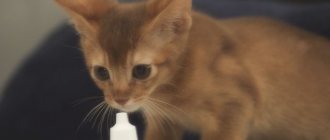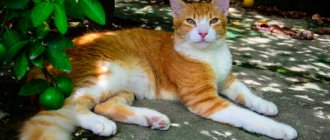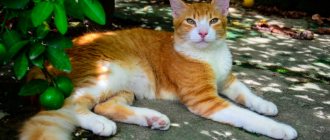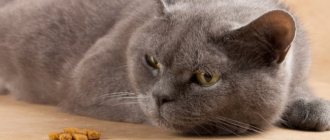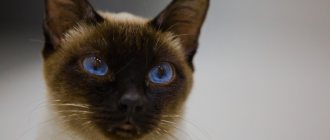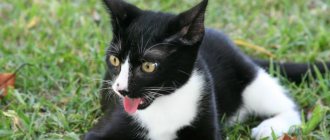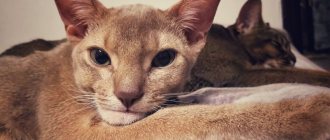If your cat sneezes, you should not give up and assume that it is absolutely safe. It’s one thing if we are talking about short-term sneezing, which usually occurs due to dust particles getting into the nose. So, the cat sneezes for a while and stops.
Another picture is presented by a long-term condition in which the cat often sneezes and rubs its nose with its paw. Here you should be wary and go to a veterinary clinic to determine the cause and further solve the problem.
Physiological causes of sneezing
If the condition of the mustachioed pet is stable, and the duration of sneezing does not cause concern, there is a high probability of a physiological cause. In this case, the reflex is awakened by external stimuli that appear during rare cleaning or a certain microclimate in the room. Also, a sneeze can be explained by a specific body structure characteristic of a particular breed.
Ingress of dust or debris
A kitten's nose is very sensitive, and its owners are incredibly inquisitive. The mustachioed fidgets are constantly exploring something, climbing into secluded corners inaccessible to their two-legged owners. Direct contact with dust or debris irritates the nasal mucosa, causing a defensive reaction.
Try to do wet cleaning more often, but don’t go to extremes. A cat is a “liquid”. If she needs it, she will crawl through any crack, despite her parameters. It is unrealistic to achieve complete sterility, so it is enough just not to forget about regular room hygiene.
Dry indoors
Dry air dries out the secretions that lubricate the nasal mucous membranes. The protective barrier becomes thinner, increasing the likelihood of catching a cold or infection.
Lack of moisture can be noticed by peeling of your own skin and strong electrification of hair. If there are plants in the house, they begin to dry out at the tips of the leaves. Children and pets often experience coughs and runny noses. Solving the problem is quite simple - place buckets of water around the house, hang wet towels, or resort to a modern method - buy an air humidifier.
Breed Features
One of the reasons why a kitten constantly sneezes is the anatomical feature of the structure of its muzzle. This is typical for representatives of extreme breeds: exotics, Himalayans, Persians, British and Scottish. All of them were bred artificially and, unlike aboriginal cats, escaped natural selection.
The experiments of breeders trying to create an unusual appearance have led to the appearance of a funny flattened muzzle with a small nose. Despite their attractive appearance, such animals often suffer from problems with the respiratory system and are predisposed to many genetic diseases.
Foreign object
Our fluffies quite often sniff surrounding objects (especially new ones), and can inhale dust, hairs and their undercoat, particles of litter, small threads, and so on.
The nasal canals of cats are thin, for this reason the smallest object clogs the passage, thereby severely irritating the mucous membrane. And then the cat begins to sneeze reflexively.
This situation can be identified by the following signs:
- The cat snorts;
- Repeatedly scratches nose with paws;
- Rubs a certain part of the muzzle against other objects, furniture, etc.;
- Constantly sneezes.
In this situation, discharge may form - usually it is a slightly thick transparent mucus. This is a natural defense of the body that helps clear the nasal passage. If the mucous membrane is damaged, then ichor or blood may be present in the mucus.
Diseases that cause frequent sneezing
If attacks become more frequent and accompanying symptoms appear, it is more reliable to get diagnosed. After an examination, the veterinarian will determine why the kitten is sneezing and what to do to normalize its condition.
Viruses and bacteria
With an infectious disease, in addition to sneezing, other alarming symptoms appear. The baby's nose becomes hot and dry. Fever, runny nose and cough appear. Tearfulness increases, and discharge from the eyes and nose may contain impurities of pus or blood. The small pet loses activity and refuses to eat. Possible intestinal upset and vomiting.
Most often, kittens are diagnosed with calcivirosis, rhinotracheitis, chlamydia and bordetellosis. All these pathologies affect the upper respiratory tract and can provoke the development of pneumonia. Their occurrence can be prevented through vaccinations and following preventive recommendations.
Allergy
Frequent sneezing, sniffles, red eyes and itching are the main symptoms of allergies. Allergens include pollen, decorative cosmetics, household chemicals, tobacco, house dust, litter, food and many other irritants. It is very difficult to recognize the cause of allergies on your own, so you cannot do without the help of a veterinarian.
Lack of timely assistance is fraught with exacerbation of attacks and the appearance of bronchial asthma. In severe cases of this pathology, the animal may die from suffocation.
Parasitosis
Irritation of the upper respiratory tract is caused by lung and heartworms, which pose a mortal danger to the infected person. In addition to increased tearing, breathing problems and a runny nose, parasitosis causes diarrhea and nausea. The waste products of helminths poison and weaken the body. Your pet may suddenly lose weight even if it maintains its appetite.
Nasal polyps
Polyps are growths that arise due to deformation of the mucous membrane. They can move around the nasal cavity and are usually not accompanied by pain. Due to the blockage of air passages, the animal begins to suffer from a lack of oxygen. This is accompanied by wheezing, snoring and copious discharge of clear fluid.
Foreign body
Smell is one of the ways to understand the world. A small pet becoming familiar with a new object may accidentally inhale it. If the object that gets inside turns out to be too large, it will be impossible to remove it on your own. The baby will sneeze and scratch his nose. If the mucous membrane is damaged, the resulting discharge may turn scarlet.
Cold
The symptoms of a cold and an infection are similar. The only difference is that in the first case the animal gets sick due to hypothermia. The immune system fails when exposed to a draft for a long time, walking in inclement weather, wool that is not sufficiently dried after bathing, frequent use of air conditioning, and other situations that disrupt natural heat exchange. A weakened body is more vulnerable to viruses and bacteria, so a secondary infection may occur against the background of a cold.
Oral problems
Dental diseases can be recognized not only by sore gums and sore teeth, but also by sneezing. Usually the reflex is awakened by inflammation and is accompanied by increased salivation and snoring.
Oncology
Nasal cavity cancer is a rare disease typical of older animals and representatives of the European Shorthair breed. Usually, owners notice it at a late stage, when the pet develops mucous discharge with blood and begins to have convulsions. It is almost impossible to save the animal by this time. To avoid a fatal outcome, veterinarians recommend checking a kitten at risk immediately after the appearance of frequent sneezing, loud snoring and heavy discharge.
Infection
Against the background of a weakened immune system, a cat may develop an infectious disease, which, as a rule, is also accompanied by a runny nose, discharge from the eyes and fever. Some infections are very strong and therefore can affect even completely healthy cats. In this case, you should contact your veterinarian.
If a cat coughs along with sneezing, this is a symptom of a viral disease - rhinotracheitis. It is very dangerous, so drug treatment is needed.
Associated symptoms
The likelihood of pathological causes increases along with the expansion of symptoms. If you notice at least one of the symptoms listed below, be sure to sign up for a diagnosis at a veterinary clinic.
Difficulty breathing and wheezing
When cats have breathing problems, they wheeze, snore, or begin to breathe from their belly. This method of breathing is accompanied by a distinct movement of the abdominal cavity and weak movement of the ribs. These changes indicate pain that interferes with normal pulmonary breathing.
Wheezing, whistling, and sniffling occur when mucous or watery fluid accumulates. This occurs with internal injuries, pneumonia, allergies and swelling.
Lacrimation and suppuration of the eyes
Pay attention to the amount and nature of discharge. Excessive leakage of fluids, the appearance of pus, blood or other impurities is an alarming sign characteristic of an infection or tumor.
Cough
A coughing attack resembles vomiting, but excludes the appearance of a watery mass. The sick animal presses itself to the floor, stretching its neck and shuddering in convulsions. Isolated cases are not dangerous and go away on their own. If the frequency increases and your pet begins to wheeze and cough up mucus, call your doctor.
Nose bleed
A condition accompanied by the appearance of blood always requires medical intervention. Nosebleeds occur with injuries, allergic reactions, colds, inflammatory processes and low air humidity. Blood from damaged vessels can drain into the stomach, causing vomiting, or rise through the nasolacrimal duct directly to the eye sockets.
Asymptomatic sneezing
The absence of symptoms is not always a reason to celebrate. If the sneezing persists and there is no clear connection with physiological reasons, it is better to play it safe. Some pathologies may remain asymptomatic for a long time. It is impossible to detect them in the early stages on your own, so it is safer to take a blood test and do an ultrasound with x-ray.
Allergy
Allergies can also be a common reason why a cat starts sneezing; common allergens are:
- Dust mites;
- Pollen and juice of various plants;
- Various preservatives in industrial feeds;
- Household chemicals (detergents, powders, etc.).
Symptoms of an allergic reaction are frequent sneezing, the flow of various fluids from the nose and eyes, conjunctivitis, and regular scratching. If the allergic reaction is very strong, then the cat scratches the skin a lot, this may cause some of the hair to fall out, and sometimes large bald patches will form.
To prevent allergies in a cat, you need to eliminate the source of the allergen. If you are unable to find it yourself, then you need to contact a veterinary clinic for examination.
What is reverse sneezing?
Reverse sneezing, or reverse breathing, is an involuntary inhalation that resembles a suffocation attack. Most often it occurs in brachycephalic dogs, but is sometimes diagnosed in sphinxes and other felines. Despite the frightening picture, this condition is not a pathology and goes away on its own.
If a mustachioed pet sharply stretches its neck and begins to swallow air noisily, do not rush to get scared. A similar effect is observed when quickly absorbing food or playing too actively. The only cause for concern is too frequent attacks, accompanied by the appearance of other alarming symptoms.
How to treat a sneezing cat?
Treatment for cat sneezing usually focuses on treating the underlying cause, if possible.
Although there are a wide range of treatment options available, owners should be aware that the goal in most cases, especially chronic ones, is to reduce the frequency and severity of symptoms rather than cure them.
More research is needed to fully understand the role that infections play in feline sneezing, but repeated or long courses of antibiotics have been shown to be effective in controlling clinical signs.
Antibiotics
Although bacterial infections are rarely the main problem, antibiotics are often used in such cases as they make the cat feel better fairly quickly.
Nasal lavage
Nasal lavage under general anesthesia may temporarily relieve clinical symptoms, regardless of cause, and may dislodge occult foreign material.
Other treatments
Other treatments that have varying levels of effectiveness include:
- Humidifiers or nebulizers
- L-lysine to minimize herpes virus flare-ups
- Steroids
- Antihistamines (cetirizine is much better than diphenhydramine in cats)
- NSAIDs
- Decongestants
- Medicines for nausea
- Surgery (in rare cases)
What to do if your kitten sneezes often
Treatment for a mustachioed pet will depend on the diagnosis. The owner can only temporarily extinguish the symptoms on his own. Without eliminating the root cause, they will recur over time, so home care is only effective under the supervision of a veterinarian.
At home
Place the kitten in a warm, draft-free place. If you have difficulty breathing, be sure to inhale warm and moist air. A bathroom filled with steam after a hot shower is suitable for this.
Do not allow your eyes to stick together due to accumulated fluid. Remove discharge with a cotton pad soaked in plain water or saline solution. If bleeding occurs, apply ice wrapped in thick cloth to your pet's nose and immediately go to the veterinarian.
Treatment prescribed by a veterinarian
If there is no improvement within 24 hours, the animal will have to be treated with medication. Depending on the diagnosis, the doctor may prescribe the following medications:
- antiviral;
- antibiotics;
- antihistamines;
- decongestants;
- healing ointments;
- anthelmintics;
- immunomodulators.
In particularly severe cases, surgery or chemotherapy may be required. When dental diseases are detected, dental treatment is always carried out under general anesthesia.
Help for a newborn
The habitat of newborn babies is limited. For natural reasons, they sneeze from the mother’s hairs getting into the sinuses, or from increased dryness. If the nose does not contain foreign objects, and there is a humidifier in the room with the kittens, call a veterinarian at home. At such a young age, all dosages are selected individually so as not to harm the growing body.
Foreign body
It's rare, but it happens that a small foreign object gets into a cat's nose. Then the cat’s obvious anxiety and attempts to scratch its nose with its paws will be noticeable. You need to go to the veterinarian, who will remove the object from the nose. You can try to do this yourself if the object is sticking out. Just be very careful not to damage the mucous membrane.
If a cancerous tumor has formed in the nasal cavity, the body tries to reject it by sneezing. In addition, it is simply difficult for the cat to breathe and therefore she may also sneeze.
Whatever the cause of the disease, you do not need to make a diagnosis yourself. Go to the vet.
Source
